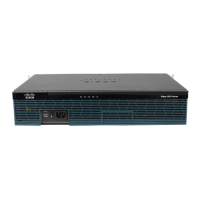8
Cisco 3900 Series, Cisco 2900 Series, and Cisco 1900 Series Integrated Services Routers Generation 2 Software Configuration Guide
Chapter Overview of the Hardware and Software
IOS Commands
IOS Commands
Table 7 lists the Cisco IOS commands and features that can trigger an erase, write, or erase and write
operation on a device's boot flash. The erase or write of an attribute on the boot flash can hold the CPU
for a few milliseconds to complete the operation. The CPU hold can result in a functional impact on
protocols or applications that are extremely time sensitive, for instance, Bidirectional Forwarding
Detection (BFD) or routing protocols which use finely tuned short timers. For example, OSPF with fast
hellos and short dead timers.
Table 7 Cisco IOS Commands
Functionality Command Name Description
Configuration
Example Impact
Write to NV
memory.
write memory This command
writes the device's
configuration in to
the Non-Volatile
RAM (NVRAM)
on the boot flash.
Use this command
in privileged
EXEC mode.
Router#write
memory
A BFD flap is triggered when one of the
following configuration elements are
activated or deactivated and configuration is
saved to memory:
(config)#warm-reboot
(config)#boot config
(config)#boot system
Changing the
configuration
register value.
config-register
value
The router has a
16-bit
configuration
register in
NVRAM. Each bit
has value 1 (on or
set) or value 0 (off
or clear), and each
bit setting affects
the router
behavior upon the
next reload power
cycle. Use this
command in
Global
configuration
mode.
Router(config)#
config-register
0xvalue
Potential enough to flap bfd.

